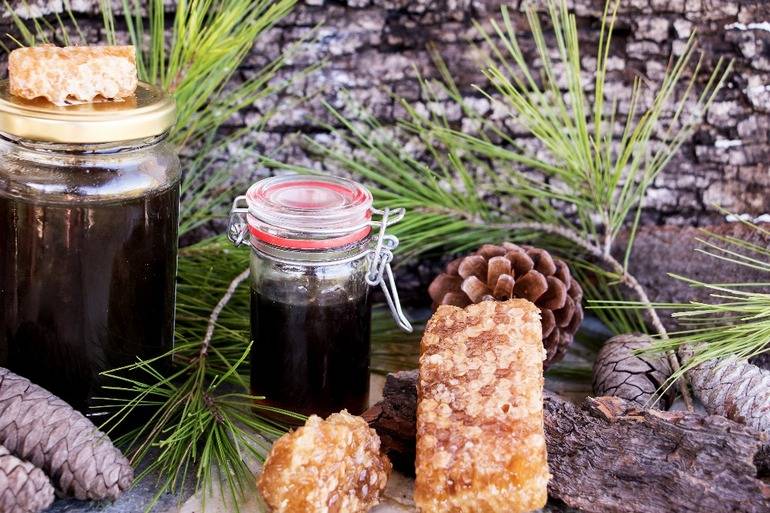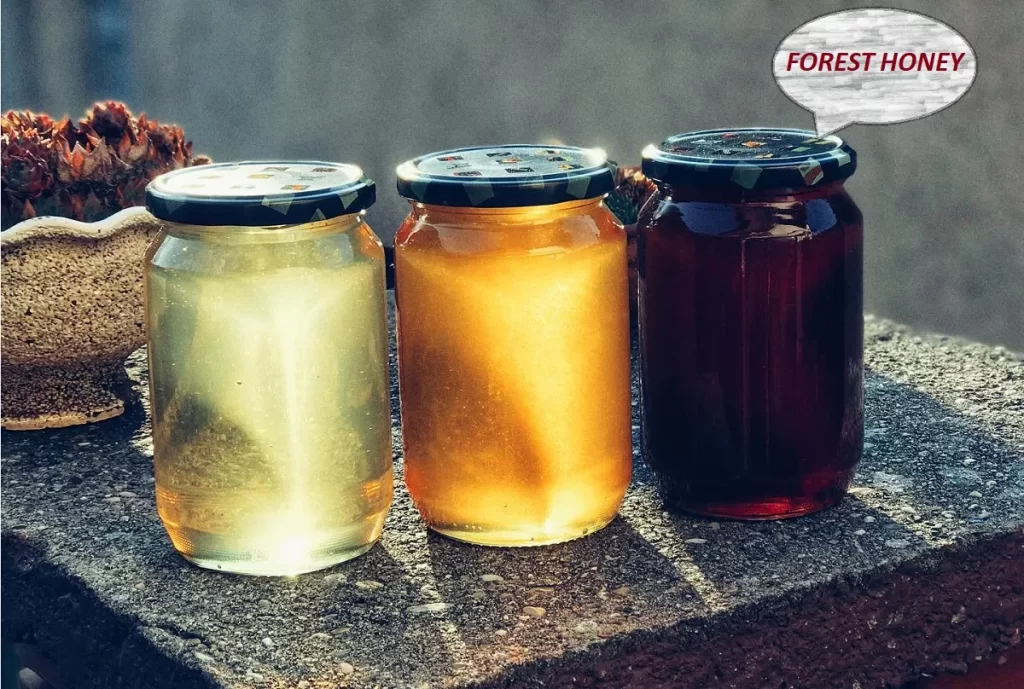Honey is natural food. It has a special taste and smell, a complex energy composition, and its medicinal properties cannot be denied.
Whether you like it or not, you have probably heard about how honey can be useful besides the kitchen. It has a positive effect on health, skin care, and who hasn’t heard that you can even lose weight with honey?

But have you heard of forest honey? It is also made by bees, but with a little help from other insects. Natural pure forest honey (the one that is not mixed with flower honey) is really hard to find. It offers all the benefits like other types of honey, but it is still a little enhanced.
What Exactly Is That Forest Honey?
When bees visit linden, acacia, and chestnut forests and collect nectar from their flowers, such honey is called linden, acacia, and chestnut honey, respectfully. So what is the deal with forest honey? How is it made?
It is generally known that bees collect nectar from flowers to make honey, and it is less known that they also collect other sweet juices. Honey that is not a product of flower nectar but of honeydew is called forest honey.
Forest honey is obtained from honeydew, not from flower nectar.
Honeydew is so healing that even the ancient Romans thought it was a gift from heaven, and until the sixties of the last century it was thought that honeydew was secreted by trees, when actually honeydew is a sticky mass rich in carbohydrates secreted by aphids and other plant insects.
Honeydew most often appears in conifer and deciduous forests at a time when the nights are cold and the mornings are warm. It is very important that the air humidity is high, otherwise the water from the juice would evaporate, the juice would become thick, and the bees would not be able to collect it.
Honeydew also occurs in deciduous and evergreen forests during summer growth, and it is even possible to find it on grass and corn. On deciduous trees it is mostly found in oak forests, on willow, linden, maple, and cherry trees.
Honeydew in coniferous forests is most commonly found in mountainous regions, on fir, spruce, pine, and larch. Therefore, forest honey is not a product of nectar glands of flowers, but rather plant juices from the deeper layers of the plant (phloem), which bees cannot reach under normal conditions.
Aphids damage leaves, needles or young twigs, so sweet plant juices come out, and the residue that aphids cannot process, appears as honeydew.
A part of honeydew comes out spontaneously through damage to the plant tissue. Warm and humid weather favors the production of honeydew. Rain destroys it, and in dry weather it thickens while still on the tree. Mild winters are important for overwintering of aphids. During summer we can often notice honeydew on cars parked under treetops.
It is possible that at high altitudes and mountains, along with favorable weather conditions, many honey-bearing plants bloom in glades and meadows which provide enough nectar for honey production, although then it is not the case of forest honey, but flower honey.
The Main Difference Between Flower And Forest Honey
To begin with, forest honey is 13 times richer in minerals and amino acids than flower honey. Forest honey also has a higher level of sucrose, dextrin, and mineral substances, as well as reduced proportion of glucose and fructose because honeydew does not contain ferments like nectar.

In general, forest honey is richer in amino acids and oligosaccharides-probiotics that have a beneficial effect on bacteria in digestive system, so forest honey is often recommended for digestive issues.
Forest honey is much darker, has a more bitter taste, more intense smell and contains fewer acids than flower honey. Due to the low level of fructose and glucose, and the ratio of glucose to water, forest honey is much more resistant to crystallization and contains more antibiotic properties than flower honey.
Healing Properties Of Forest Honey: Who Is Forest Honey Especially Recommended To?
Due to its rich medicinal composition and strong smell, forest honey was much more valued than it is today, and it was most often used to treat respiratory diseases.
Unfortunately, few people today know that forest honey is one of the highest quality types of honey in the world.
Forest Honey Is A Natural Probiotic
Oligosaccharides present in honeydew act as probiotics that promote the growth of beneficial bacteria present in the intestines. It is very effective if consumed after taking antibiotics when treating bacterial infections.
Improving the intestinal flora also increases the appetite.
Forest Honey Is Recommended For Diseases Of The Respiratory Tract
Forest honey owes its impressive antibacterial properties to a high pH level, low moisture content, and hydrogen peroxide-a powerful disinfectant that naturally occurs as a result of the reaction between glucose, sugar, and enzymes secreted by bees.
For this reason forest honey is recommended for sore throats, for alleviating cough, and for quick recover after severe illnesses and respiratory diseases, especially with pneumonia.
Forest Honey Is Recommended For Diabetics
Honey itself has a low glycemic index and is known as a healthier substitute for sugar. Since forest honey is not obtained from sweet flower nectar, it contains even less sugar, so it is recommended for diabetics.
Forest Honey Strengthens The Circulatory System And Reduces The Risk Of Tumor Development
Forest honey is rich in flavonoids- phytochemicals ubiquitous in nature, many which appear in vegetables, fruit and beverages such as tea, wine, coffee, and fruit-based juices.
Flavonoids act as strong antioxidants and our body uses them to reduce inflammatory reactions, lower high blood pressure, accelerate and strengthen blood flow, and suppress free radicals that can cause diseases and cause aging of the body.
A considerable interest has aroused due to research that showed that the consumption of foods rich in these phytonutrients is associated with a significantly lower risk of developing tumors of the mouth, groin, colon, breast, kidney, and ovary.
Forest Honey Is Recommended For Athletes
Forest honey contains mineral salts that participate in a number of bodily functions. They maintain the work of the nervous system, regulate digestion and body fluid levels.
Since mineral salts balance the body’s hydration, forest honey is especially recommended for athletes who lose a large amount of water and salt from the body through sweating. After training, it is enough to dissolve two tablespoons of honey in a glass of water.
Forest honey is also recommended for pregnant women, but those with more sensitive stomachs should be careful with its consumption because its aromatic properties can stimulate the production of gastric acid.

